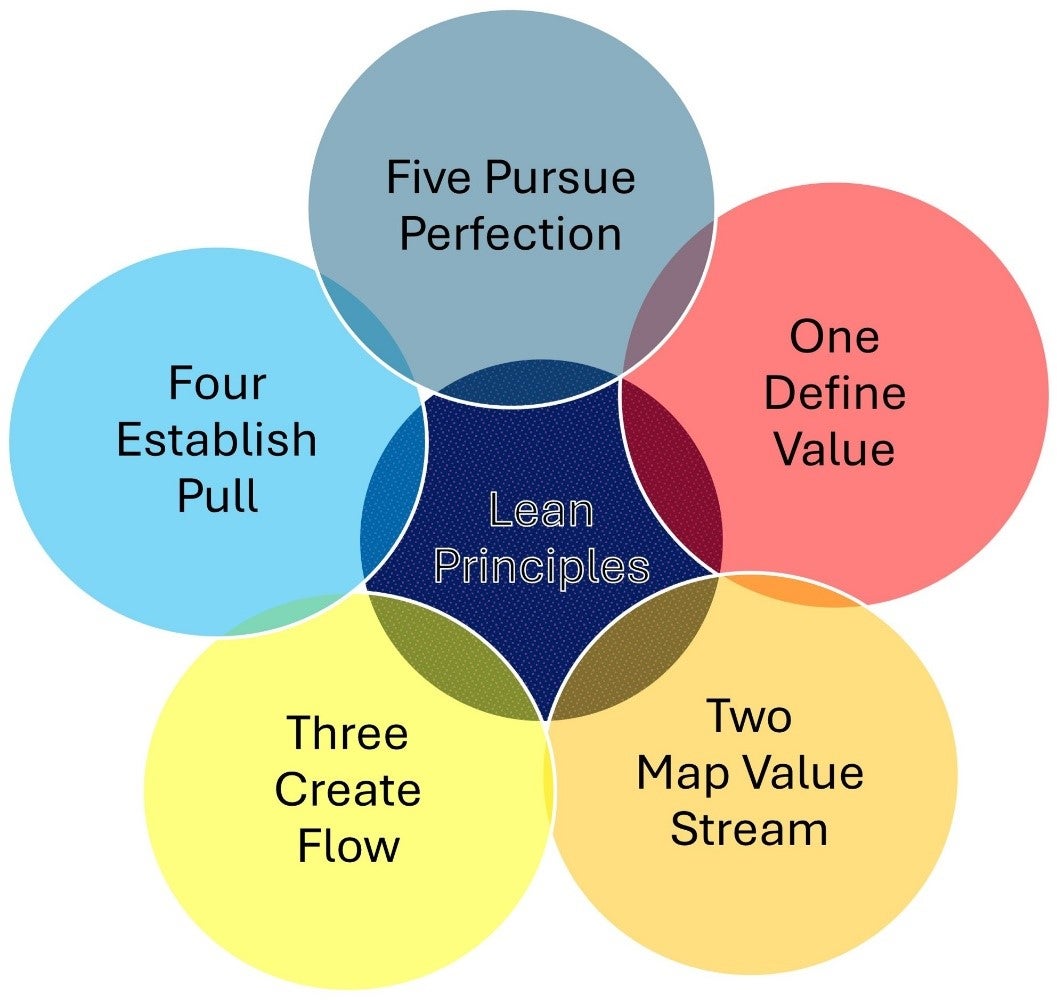PART 2: METHODOLOGIES, PRINCIPLES AND TOOLS
3 Chapter 3: Lean Principles and Tools
Introduction
Operational excellence is the cornerstone of sustained business success. It is characterized by the consistent and reliable execution of a company’s strategy to outperform competitors. At the heart of operational excellence lies the disciplined application of Lean principles and tools. Originating from the manufacturing powerhouse of the Toyota Motor Corporation, Lean methodologies have since been adopted across various industries to enhance efficiency, reduce waste, and deliver greater value to customers.
This chapter delves into the core principles and tools of Lean. It will provide a comprehensive guide to understanding and applying these concepts in real-world scenarios. This chapter will explore the foundational principles of Lean, the transformative power of value stream mapping, and the identification and elimination of waste. These subjects will set the stage for achieving significant improvements in operational performance.
This chapter begins with an in-depth look at the five core principles of Lean. It will explain how each principle contributes to creating value and minimizing waste. Following this, it will explore value stream mapping as a vital tool for visualizing and improving processes. Next, it will examine the eight types of waste (Muda) that Lean aims to eliminate and offer practical strategies for addressing each type. Finally, this chapter will discuss how these Lean principles and tools can be leveraged to drive operational excellence. It will provide real-world examples and case studies to illustrate the application of Lean concepts.
Learning Objectives
- Explain the five core principles of Lean
- Apply value stream mapping to identify and eliminate waste
- Demonstrate the use of the Five Whys and root cause analysis to identify problems
- Explain how Lean principles can drive operational excellence
Learning Outcomes
By the end of this chapter, you will have a solid understanding of how to apply Lean principles and tools to streamline operations, enhance efficiency, and deliver superior value to customers. This knowledge will equip you to lead your organization to operational excellence, and it will ensure sustainable growth and competitive advantage.

The Five Lean Principles
The five Lean principles were first articulated by James P. Womack and Daniel T. Jones in their seminal book, Lean Thinking: Banish Waste and Create Wealth in Your Corporation, published in 1996. However, the principles themselves originate from the practices of the Toyota Production System (TPS), as developed by Toyota Motor Corporation in Japan in the mid-20th century.
Lean is a systematic method to minimize waste within a manufacturing system without sacrificing productivity. The five core principles of Lean are listed below.
1. Specify Value:
Definition: Value is defined by the customers, and it is whatever they are willing to buy.
Application: Identify what is valuable to the customer, and focus all activities on delivering this value. To obtain value, obtain direct feedback from customers or market research.
Example: In an automotive company, customers value reliability and fuel efficiency. The company should prioritize the activities that enhance these features.
2. Map the Value Stream:
Definition: The value stream is the entire process flow, from the raw materials to the finished product, that adds value.
Application: Create a visual representation of all the steps in the process. Identify the steps that add value and those that do not.
Example: In the automotive industry, mapping the process of manufacturing a car, from the point of receiving raw materials to that of delivering the finished product to the customer
3. Create Flow:
Definition: Ensure that the production steps flow smoothly without interruptions.
Application: After removing non-value-adding steps, rearrange the remaining steps to create a continuous flow.
Example: In a manufacturing plant, organizing workstations in a sequence that mirrors the production process to minimize delays
4. Establish Pull:
Definition: Products are created in response to customer demand, rather than pushing products based on forecasts.
Application: Implement Just-in-time (JIT) production systems to reduce inventory and increase responsiveness.
Example: Using customer demand to trigger production schedules, rather than producing based on estimated demand with costly inventory
5. Pursue Perfection:
Definition: Continuous improvement (Kaizen) to strive for perfection.
Application: Regularly assess processes and make incremental improvements to enhance efficiency and quality.
Example: Implementing regular Gemba walks is Kaizen. To see where the actual work happens, identify potential improvements with the employees, and experiment with new methods to optimize production
Impact and Evolution
Since the publication of Lean Thinking, the five Lean principles have been widely adopted across industries and geographies. They have influenced numerous methodologies and frameworks that aim to improve organizational performance, including Lean Six Sigma, Agile, and Continuous Improvement.
The principles of Lean continue to evolve. Lean integrates new tools and techniques to address emerging challenges in a rapidly changing business environment. Its fundamental focus on delivering value, eliminating waste, and pursuing continuous improvement remains central to the Lean philosophy, and it drives operational excellence in diverse contexts.
Value Stream Mapping (VSM)
Value stream mapping (VSM) is a key Lean tool. It is used to visualize the flow of materials and information as a product or service makes its way through the value stream. It helps to identify and eliminate waste, ensuring that each step adds value to the final product.
In their book, Value Stream Mapping: How to Visualize Work and Align Leadership for Organizational Transformation, Karen Martin and Mike Osterling provide a detailed approach to understanding and implementing VSM as a tool to transform organizations. Below is an in-depth look at the VSM process as outlined in this book.
Overview of Value Stream Mapping
VSM is a visual tool. It helps organizations understand the flow of materials and information required to bring a product or service to the customer. VSM highlights value-adding steps versus non-value-adding (waste) steps, enabling organizations to streamline their processes and improve their overall efficiency.
Steps in the Value Stream Mapping Process
1. Preparation and Planning:
Define the Scope: Clearly define the boundaries of the value stream to be mapped. This includes deciding on both the start and end points of the process.
Select the Product or Service Family: Choose a specific product or service family for focus, ensuring that it represents a significant portion of the business.
Assemble the Team: Form a cross-functional team with representatives from the different areas that are involved in the process. This team will provide diverse perspectives and expertise.
2. Mapping the Current State:
Walk the Process: The team physically walks through the process from start to finish. They gain a firsthand understanding of each step. This helps to identify the actual flow of materials and information.
Collect Data: Gather detailed data on each step. This includes cycle times, lead times, inventory levels, and any delays or .
Create the Current State Map: Using the collected data, create a visual representation of the current state of the process. This map should include all steps, including both value-adding and non-value-adding steps, as well as relevant metrics.
3. Analyze the Current State:
Identify Waste: Examine the current state map to identify areas of waste, such as delays, excess inventory, and unnecessary movements.
Root Cause Analysis: Use tools such as the Five Whys and RCA to understand the underlying causes of waste and inefficiencies.
4. Designing the Future State:
Define Value: Clarify what constitutes value from the customer’s perspective and ensure all activities align with delivering this value.
Eliminate Waste: Develop strategies to eliminate the identified waste. Streamline steps, reduce inventory, and improve flow.
Establish Flow and Pull: Redesign the process to create a continuous flow and implement a pull system where production is based on actual customer demand.
Create the Future State Map: Visualize the improved process with the proposed changes, highlighting how they will address the inefficiencies of the current state.
5. Developing an Action Plan:
Prioritize Improvements: Identify the most impactful changes and prioritize them based on feasibility and potential benefits.
Assign Responsibilities: Allocate specific tasks to team members and set clear deadlines for implementation.
Create a Timeline: Develop a detailed timeline for executing the changes. Include milestones and checkpoints to monitor progress.
6. Implementing and Monitoring:
Execute the Plan: Implement the proposed changes according to the action plan. This may involve training employees, modifying equipment, and adjusting workflows.
Monitor Progress: Continuously monitor the process to ensure that the changes are having the desired effect. Use metrics and key performance indicators (KPIs) to track improvements.
Adjust as Needed: Be prepared to adjust based on feedback and observed results. Continuous improvement is key to sustaining the benefits of VSM.
7. Sustaining the Improvements:
Standardize Processes: Document the improved processes and establish standard operating procedures (s) to ensure consistency.
Train Employees: Provide ongoing training to employees to maintain the new standards and encourage a culture of continuous improvement.
Review and Refine: Regularly review the value stream and make further refinements as needed. This helps to maintain the gains and adapt to any changes in the business environment.
Benefits of Value Stream Mapping
Enhanced Visibility: VSM provides a clear visual representation of a process. It makes the process easier to understand and communicate.
Identify Waste: By taking note of non-value-adding activities, VSM helps organizations focus on eliminating waste.
Improved Efficiency: Streamlining processes and reducing waste lead to faster cycle times and lower costs.
Customer Focus: VSM ensures that every step adds value and aligns the organization its customers’ needs and expectations.
Facilitate Change: VSM creates a shared vision for improvement, aligning leadership and employees with common goals.
Video on creating a value stream map. (19 minutes)
Video Source: YouTube.com [1]
Study Questions
- Watch for the start and end points. What are they?
- Watch for value-added time. What percentage of it is wait time?
VSM can be used for the current state and the future state. It can also be used in non-manufacturing environments. Notice the yellow splashes with “Investigate” towards the end of the video. Each one can be a Kaizen project.
Example of VSM Application
Consider a software development company that faces delays in releasing new features. The VSM process would involve the following steps:
- Map the current development cycle from initial requirements gathering to deployment.
- Identify bottlenecks, such as approval delays and excessive rework.
- Design a future state with streamlined approval processes and enhanced collaboration tools.
- Implement changes, such as automated testing and continuous integration, to reduce cycle times.
- Monitor the new process to ensure it delivers the desired improvements.
By following these steps, the company can reduce , improve product quality, and better meet its customers’ demands.
Another Example of VSM Application
Consider a healthcare clinic striving to reduce patient wait times. By mapping the current state, the clinic identifies delays in patient processing and redundant steps in paperwork. The future state map removes unnecessary steps and introduces parallel processing for certain tasks. These actions reduce wait times and improve patient satisfaction.
Conclusion
VSM is a powerful tool for visualizing and transforming organizational processes. By following the structured approach outlined in the 2013 book by Osterling and Martin, Value Stream Mapping: How to Visualize Work and Align Leadership for Organizational Transformation, organizations can identify inefficiencies, streamline operations, and drive significant performance improvements. This aligns with the broader goals of Lean principles and ultimately leads to enhanced value for customers and sustained operational excellence.
The Eight Wastes (Muda)
In Lean, waste (Muda) refers to any activity that does not add value for the customer. Below are the eight types of waste (according to Tim Woods).
1. Transportation:
Unnecessary movement of products or materials.
Example: Moving materials between distant workstations.

2. Inventory:
Excess products or materials that are not processed quicky
Example: Overstocking raw materials that are not immediately needed

3. Motion/Unnecessary Movement of People:
Example: Employees walking long distances to fetch tools
4. Waiting:
The idle time that occurs when processes are not synchronized
Example: Waiting for approval or materials

5. Overproduction:
Producing more than is needed
Example: Manufacturing products based on forecast rather than actual demand
6. Over-processing:
Doing more work than necessary
Example: Using overly complex processes that do not add value
7. Defects:
Errors or mistakes that require rework
Example: Producing faulty products that need correction

8. Skills:
Underusing people’s talents and skills
Example: Assigning skilled workers to menial tasks that do not engage their capabilities
Strategies to Eliminate Waste
- Transportation: Redesign the layout to minimize movement.
- Inventory: Implement JIT systems to align inventory with demand.
- Motion: Organize workstations to reduce unnecessary movement.
- Waiting: Balance workloads and streamline processes.
- Overproduction: Align production with actual demand.
- Over-processing: Simplify processes and eliminate non-value-adding steps.
- Defects: Implement quality control measures and a continuous improvement practice.
- Skills: Train employees and use their skills effectively.
Applying Lean Principles for Operational Excellence
Operational excellence is achieved through the consistent application of Lean principles, as these principles streamline processes, reduce waste, and enhance value.
Case Study: Manufacturing Plant
A manufacturing plant faces issues with long lead times and high operational costs. Through Lean principles, the plant can transform its operations. Below are the principles that the plant can engage to address its issues.
- Specify Value: Survey customers to understand what they value most in the products.
- Map the Value Stream: Create a detailed map of the current production process.
- Create Flow: Identify and eliminate bottlenecks to ensure a smooth production flow.
- Establish Pull: Implement a JIT system to produce based on actual customer demand.
- Pursue Perfection: Regularly review processes and implement Kaizen for continuous improvement.
Benefits
- Reduced Lead Times: Streamlined processes lead to faster production.
- Lower Costs: Eliminating waste reduces operational costs.
- Improved Quality: Continuous improvement enhances product quality.
- Higher Customer Satisfaction: Delivering value improves customer satisfaction and loyalty.
Conclusion
Lean Six Sigma provides a powerful framework for achieving operational excellence. By understanding and applying the five core principles of Lean, using value stream mapping, and systematically eliminating waste, organizations increase efficiency, reduce costs, and deliver greater value to their customers. Continuous improvement and a focus on value are the cornerstones of sustained operational success.
Chapter Summary
This chapter describes the steps involved in leveraging Lean Six Sigma principles to achieve operational excellence. It provides Lean Six Sigma’s practical insights and strategies to implement in any organization.
References
Dennis, P. (2016). Lean Production Simplified: a plain language guide to the world’s most powerful production system. CRC Press.
Liker, J. K. (2004). The Toyota Way: 14 management principles from the world’s greatest manufacturer. McGraw-Hill Education.
Martin, K., & Osterling, M. (2013). Value Stream Mapping: how to visualize work and align leadership for organizational transformation. New York McGraw Hill Professional.
Ohno, T. (1988). Toyota Production System: beyond large scale production. Productivity Press.
Rother, M., & Shook, J. (2003). Learning to See: value stream mapping to create value and eliminate muda. Lean Enterprise Institute.
Womack, J. P., & Jones, D. T. (1996). Lean Thinking: banish waste and create wealth in your corporation. Simon & Schuster.
- “How to Value Stream Map [Step by Step]” by Adriana Girdler, https://youtu.be/7wD7R6x3Pv4?si=9HQqcjHAzRdnxwGqURL (Accessed November 8, 2024) ↵
Points in a process that limit the overall flow and speed of operations.
Example: When only one checkout counter is open at the grocery store, it becomes a bottleneck as everyone must wait in that single line.
(Standard Operating Procedure) Written steps for doing tasks.
Example: Recipe for making your favorite sandwich.
Time to develop and launch new product.
Example: Time from idea to selling your first batch of homemade bracelets.

